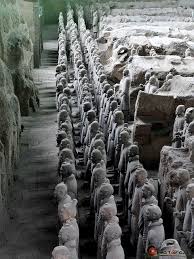
What's Inside the Terracotta Army's Pit No. 1?
Of the four principal seven-meter-deep pits, pit no. 1 is the largest: it measures about 210 by 60 meters and features 11 parallel corridors containing more than 3,000 terracotta figures. [2] Arranged in military formation, these figures were intended to serve as the grand army for the underground imperial palace.
The Layout of Pit No. 1
Pit No. 1 is laid out in a rectangular shape, resembling a real-life military encampment. The 11 corridors are separated by earthen walls, with the soldiers facing east, ready to defend the tomb against potential threats.
The Three Main Sections of the Army
The army within Pit No. 1 is strategically arranged into three main sections: the vanguard, the main force, and the rear guard.
- The Vanguard: Located at the front of the formation, the vanguard consists of archers and crossbowmen, poised to repel any initial attacks.
- The Main Force: Forming the heart of the army, the main force is composed of heavily armored infantrymen armed with spears, swords, and halberds. They are arranged in tight formations designed for maximum impact in close combat.
- The Rear Guard: Positioned at the back, the rear guard consists of chariots driven by skilled charioteers and accompanied by armed soldiers. This unit provided both offensive and defensive capabilities, offering support and flanking maneuvers.
The Variety and Detail of the Terracotta Figures
The sheer variety and meticulous detail of the terracotta figures are astounding.
- Different Ranks: The figures depict warriors of different ranks, from high-ranking generals identifiable by their elaborate armor and headgear, to ordinary soldiers with simpler attire.
- Facial Expressions: Each figure boasts a unique facial expression and features, suggesting individual personalities and origins.
- Weapons and Armor: The weapons and armor are incredibly lifelike and accurately reflect the military technology of the time.
- Horses: In addition to the soldiers, pit no. 1 also features hundreds of terracotta horses, some pulling chariots, others standing alongside their riders.
The Significance of the Terracotta Army
The Terracotta Army, particularly the grandeur of Pit No. 1, offers invaluable insights into the military organization, weaponry, and cultural practices of the Qin Dynasty.
- Military Might: It reflects the immense power and ambition of Qin Shi Huang, the First Emperor of China, who sought to conquer and unify China.
- Artistic Achievement: The Terracotta Army stands as a testament to the artistic skill and craftsmanship of the Qin Dynasty artisans.
- Cultural Heritage: Today, the Terracotta Army is a UNESCO World Heritage site and one of the most iconic archaeological discoveries of all time, attracting millions of visitors from around the world.
FAQs
1. How long did it take to build the Terracotta Army in Pit No. 1?
It's estimated that it took approximately 38 years to create the entire Terracotta Army, with construction beginning shortly after Qin Shi Huang ascended the throne.
2. What is the purpose of the Terracotta Army?
The Terracotta Army was intended to serve as a symbolic guardian army for Qin Shi Huang in the afterlife, ensuring his continued power and protection.
3. Are there any female warriors in the Terracotta Army?
While the vast majority of the figures are male, recent archaeological research suggests that there might have been female warriors included in the ranks. However, their exact roles and representation are still being investigated.